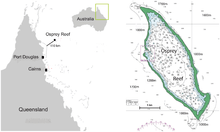Osprey Reef
Coordinates: 13°54′29″S 146°36′55″E / 13.90806°S 146.61528°E


Osprey Reef is a submerged atoll in the Coral Sea, northeast of Queensland, Australia. It is part of the Northwestern Group of the Coral Sea Islands. Osprey Reef is roughly oval in shape, measuring 25 by 12 kilometres (16 by 7 mi), and covers around 195 square kilometres (75 sq mi). It has a perimeter of 69.5 kilometres (43.2 mi).[2] The central lagoon is only 30 metres (98 ft) deep.[3]
The reef sits atop a seamount in deep water. It is an isolated location some 60 kilometres (37 mi) from other reefs. The almost vertical reef walls, which rise from a depth of about 2,000 metres (6,600 ft), are home to a dwarf form of Nautilus pompilius that is isolated from other nautilus populations by more than 100 kilometres (62 mi).[1][2][4] Schindleria brevipinguis, one of the world's smallest fish, is found in the Osprey Reef lagoon.[5]
The reef has no intertidal or emerged sand cay.[6] The surrounding waters are part of the South Equatorial Current. The reef is protected within the Coral Sea Commonwealth Marine Reserve.[7]
Corals
A 2009 expedition aimed to make discoveries in the deeper parts of the reef between 92 and 800 metres (302 and 2,625 ft) below sea level. Relict fauna communities consisting of rock sponges, glass sponges, brachiopods and stalked sea lilies were discovered.[7]
Diving
The reef has been described as the "ultimate reef diving adventure".[8] The reef is home to are large and colourful soft corals. Sharks are common.
See also
References
- 1 2 Dunstan, A. J.; Ward, P. D.; Marshall, N. J. (2011). Solan, Martin, ed. "Nautilus pompilius life history and demographics at the Osprey Reef Seamount, Coral Sea, Australia". PLoS ONE. 6 (2): e16312. doi:10.1371/journal.pone.0016312. PMC 3037366
 . PMID 21347356.
. PMID 21347356. - 1 2 Dunstan, A.; Bradshaw, C. J. A.; Marshall, J. (2011). Solan, Martin, ed. "Nautilus at risk – estimating population size and demography of Nautilus pompilius". PLoS ONE. 6 (2): e16716. doi:10.1371/journal.pone.0016716. PMC 3037370
 . PMID 21347360.
. PMID 21347360. - ↑ Osprey Reef. Dive the World.
- ↑ Dunstan, A. J.; Ward, P. D.; Marshall, N. J. (2011). Solan, Martin, ed. "Vertical distribution and migration patterns of Nautilus pompilius". PLoS ONE. 6 (2): e16311. doi:10.1371/journal.pone.0016311. PMC 3043052
 . PMID 21364981.
. PMID 21364981. - ↑ Watson, W.,; Walker, H.J. (2004). "The world's smallest vertebrate, Schindleria brevipinguis, a new paedomorphic species in the family Schindleriidae (Perciformes: Gobioidei)." (PDF). Records of the Australian Museum 56: 139–142.
- ↑ F. Sarano; M. Plchon. "Morphology And Ecology Of The Deep Fore Reef Slope At Osprey Reef, (Coral Sea)" (PDF). Proceedings of the 6th International Coral Reef Symposium, Australia, 1988, Vol.2. Retrieved 7 February 2016.
- 1 2 "Secrets of the Coral Sea revealed". Australian Geographic. 20 January 2016. Retrieved 7 February 2016.
- ↑ Simon & Schuster (2008). Dive Atlas of the World. New Holland Publishers. p. 207. ISBN 1847733174. Retrieved 7 February 2016.
External links
![]() Media related to Osprey Reef at Wikimedia Commons
Media related to Osprey Reef at Wikimedia Commons